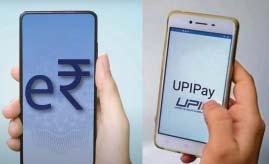
Interface (UPI) and the exploration of Central Bank Digital Currency (CBDC). This article delves into how these developments have shaped India's digital landscape and their potential impact on the nation's financial future.
The Birth of UPI
In an increasingly digital world, India has emerged as a pioneer in digital payments through its ground-breaking Unified Payments Interface (UPI). UPI has not only revolutionized transactions in India but has also set a global standard for efficient and inclusive digital payment systems.
Conceived and launched by the National Payments Corporation of India (NPCI) in 2016, UPI was a crucial part of the Indian government's push for a digital economy. UPI simplified peer-to-peer and peer-to-merchant transactions, making them easy, secure, and instantaneous. Users could link their bank accounts to a mobile app and conduct transactions using a unique UPI ID, eliminating the need for cumbersome account numbers and IFSC codes. In August 2023, UPI transactions aggregated to Rs. 10586/- million, with monthly payments valued at Rs. 15,76,536.56 crore.
Key Features and Advantages of UPI Interoperability: UPI stands out for its interoperability, allowing users to transact across different banks and payment service providers seamlessly, fostering healthy competition and choice.
Financial Inclusion: UPI has played a pivotal role in bringing millions of unbanked and underbanked individuals into the formal financial ecosystem, thanks to its user-friendly interface and accessibility through basic smartphones.
Security: UPI transactions prioritize security, with multi-factor authentication and encryption protocols safeguarding user data and funds.
This story is from the February 2024 edition of BANKING FINANCE.
Start your 7-day Magzter GOLD free trial to access thousands of curated premium stories, and 9,000+ magazines and newspapers.
Already a subscriber ? Sign In
This story is from the February 2024 edition of BANKING FINANCE.
Start your 7-day Magzter GOLD free trial to access thousands of curated premium stories, and 9,000+ magazines and newspapers.
Already a subscriber? Sign In

The Rise Of Green Marketing: Driving Sustainable Change
Green marketing refers to the practice of promoting products or services that are environmentally friendly or sustainable. It involves incorporating eco-friendly elements into various aspects of marketing strategies, including product development, packaging, advertising, and distribution.

ICICI Bank partners with PhonePe to offer instant credit on UPI
ICICI Bank announced that it has partnered with PhonePe to offer instant credit on UPI to its pre-approved customers on the app of the digital payments company.

Indiagold Eyes Major Expansion in India's Gold Loan Market
Indiagold, a prominent fintech company specialising in gold loans, is set to disrupt the gold loan industry with its ambitious expansion plans and innovative product offerings.

RBI CIRCULAR
Facilitating accessibility to digital payment systems for Persons with Disabilities Guidelines

Legal News
The Supreme Court announced the launch of a new webpage on its official website providing summaries of landmark judgments.

The Role and Impact of the Insolvency and Bankruptcy Code (IBC) in NPA Recovery
Indian banks, especially grappling with the mounting challenge of Non-Performing Assets (NPAs) within Scheduled Commercial Banks (SCBs), are experiencing a significant downturn in their capacity for credit recycling, resulting in reduced business opportunities and declining profits. However, various factors contributing to the severity of NPA problem are including macro-economic, political, and internal factors, emphasizing the complexity of the issue. With this background, the present study puts an effort to look at the role of the Insolvency and Bankruptcy Code (IBC) in NPA recovery and also showcasing its significance in resolving insolvency and maximizing creditor recovery.

Big Data in Banking: Analysing its Role, Advantages and Challenges
Globally Inflation started rising post April 2021 and went above the target range set by most of the Central Banks. It had remained low and dormant for a substantial duration since the global financial crisis. CPI inflation in developed countries such as US, UK and Euro zone, began to exceed their traditional target of 2% and continue to stay at these elevated levels till recent time.

Is SIP Always the Best Option? A Look into Lump-Sum vs SIP During Volatile Markets
SIP is a method of investing a fixed amount at regular intervals, typically monthly, into a mutual fund. It allows investors to buy more units when prices are low and fewer when prices are high, a process known as rupee cost averaging.

Strategies for Mutual Fund Retail Investors during market downturns
When stock markets experience a decline, mutual fund investors often face a sense of insecurity and apprehension. The volatility can lead to impulsive decisions, which, rather than securing financial health, may impair long-term investment objectives.

Fraud Risk Management In Banking
Fraud risk management is a fundamental aspect of overall Risk Management within the banking sector. In India, banks adhere strictly to guidelines set forth by the Reserve Bank of India (RBI) to prevent, detect, and promptly report fraudulent activities.